

Let's use video to reinvent education - Salman Khan. With a library of over 4,000 videos on everything from arithmetic to physics, finance, and history and hundreds of skills to practice, the Khan Academy is on a mission to help people learn what they want, when they want, at their own pace.Sir Ken Robinson makes an entertaining and profoundly moving case for creating an education system that nurtures (rather than undermines) creativity in his 2006 TED Talk.Listen to the story on NPR about the YouTube Phenomenon, as it celebrated its five-year anniversary in 2010.
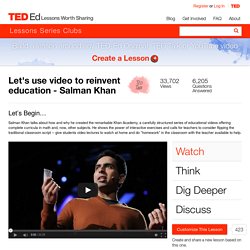
Robert Siegel talks to Alex Pham, technology journalist for the Los Angeles Times, about its effect on the online world.In 2011, the World Bank launched a new Education Sector Strategy 2020, “Learning for All.” The End of Education As We Know It. By Scott Barry Kaufman Imagine being 6 or 7 years old again, learning about addition and subtraction for the first time.
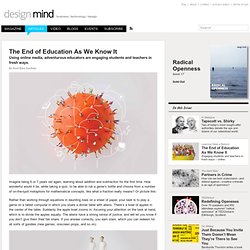
How wonderful would it be, while taking a quiz, to be able to rub a genie’s bottle and choose from a number of on-the-spot metaphors for mathematical concepts, like what a fraction really means? Or picture this: Rather than working through equations in daunting rows on a sheet of paper, your task is to play a game on a tablet computer in which you share a dinner table with aliens. There’s a bowl of apples in the center of the table. These examples may seem charming and even silly—and they’re meant to be. The new wave of educational tools include fresh ways of deploying phone and tablet apps, online games and videos, and social networking. “We should try to bring back the joy of learning because you want to learn, not because someone is going to give you a grade at the end of the semester,” Schocken said in a recent interview. No Wrong Answers Flipping the Lesson.
Sir Ken Robinson on the Power of the Imaginative Mind (Part One) Ken: Good evening.
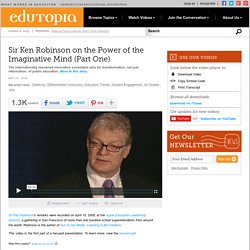
Education reform is, I think, now the major global challenge, and I just wanted to share some thoughts with you then open this up for some conversation before we're done. Who's been to Las Vegas? All: Yeah. Ken: What is that? [Laughter] Really. Don't be so literal. Thank you. Profile on TED.com. Sugatam - home. 5 Great TED Talks for Teachers. As you probably know, this year's TED 2013 prize went to Sugata Mitra for his outstanding wish " School in The Cloud ".
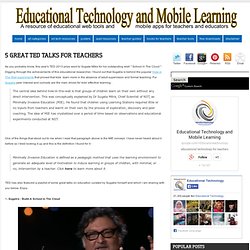
Digging through the achievements of this educational researcher, I found out that Sugatra is behind the popular Hole in The Wall experiments that proved that kids learn more in the absence of adult supervision and formal teaching. For Sugatra peer interest and curiosity are the main drives for kids' effective learning . The central idea behind hole-in-the-wall is that groups of children learn on their own without any direct intervention. This was conceptually explained by Dr Sugata Mitra, Chief Scientist of NIIT, as Minimally Invasive Education (MIE).
He found that children using Learning Stations required little or no inputs from teachers and learnt on their own by the process of exploration, discovery and peer coaching. One of the things that stood out to me when I read that paragraph above is the MIE concept. 1- Sugatra : Build A School in The Cloud.
How a Radical New Teaching Method Could Unleash a Generation of Geniuses. In 2009, scientists from the University of Louisville and MIT's Department of Brain and Cognitive Sciences conducted a study of 48 children between the ages of 3 and 6.
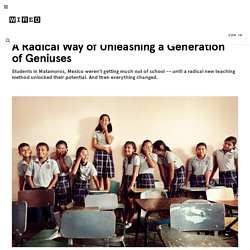
The kids were presented with a toy that could squeak, play notes, and reflect images, among other things. For one set of children, a researcher demonstrated a single attribute and then let them play with the toy. Another set of students was given no information about the toy. This group played longer and discovered an average of six attributes of the toy; the group that was told what to do discovered only about four. A similar study at UC Berkeley demonstrated that kids given no instruction were much more likely to come up with novel solutions to a problem. Gopnik's research is informed in part by advances in artificial intelligence. A Brief History of Alternative Schools New research shows what educators have long intuited: Letting kids pursue their own interests sharpens their hunger for knowledge. 1921A. Hans Rosling: The magic washing machine. Ken Robinson: How to escape education's death valley.
Sir Ken Robinson: Bring on the learning revolution! RSA Animate - Changing Education Paradigms. Did You Know 3.0 (Officially updated for 2012) HD. Critical & Creative Education.